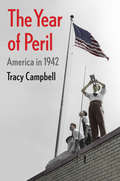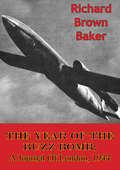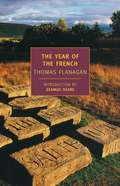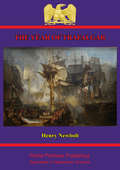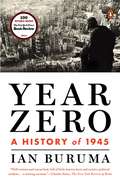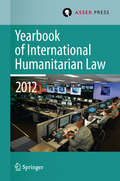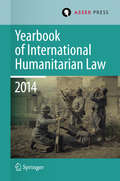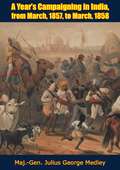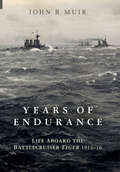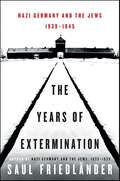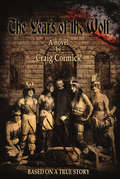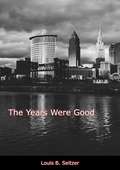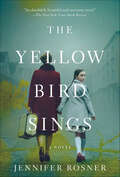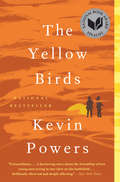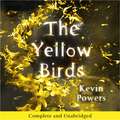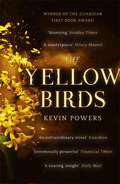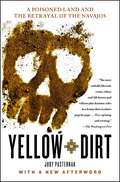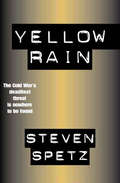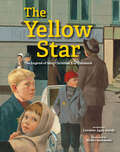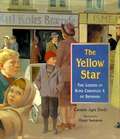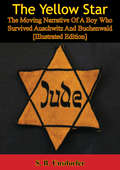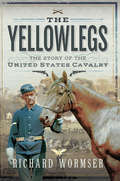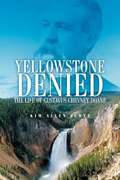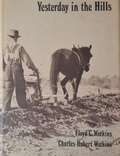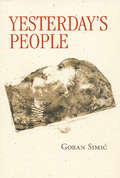- Table View
- List View
The Year of Peril: America in 1942
by Tracy CampbellA fascinating chronicle of how the character of American society revealed itself under the duress of World War II The Second World War exists in the American historical imagination as a time of unity and optimism. In 1942, however, after a series of defeats in the Pacific and the struggle to establish a beachhead on the European front, America seemed to be on the brink of defeat and was beginning to splinter from within. Exploring this precarious moment, Tracy Campbell paints a portrait of the deep social, economic, and political fault lines that pitted factions of citizens against each other in the post–Pearl Harbor era, even as the nation mobilized, government‑aided industrial infrastructure blossomed, and parents sent their sons off to war. This captivating look at how American society responded to the greatest stress experienced since the Civil War reveals the various ways, both good and bad, that the trauma of 1942 forced Americans to redefine their relationship with democracy in ways that continue to affect us today.
The Year Of The Buzz Bomb; A Journal Of London, 1944: A Journal Of London 1944
by Richard Brown BakerOne humble GI working for the OSS in London recounts his experiences under bombardment by the Nazi wonder-weapon, the V-1 flying rocket."London in April and May of 1944 was a battered, cheered hero. The whole Allied world admired the fortitude of its inhabitants, survivors of the fires and explosions of persistent Luftwaffe attacks."It was to this London that I came as one of the innumerable Americans shipped overseas for the war effort, having crossed the Atlantic on the crowded Queen Mary, nearly fifteen thousand troops aboard, which sped out of submarine range into a Scottish port toward the end of March. We came, a batch of us, by night in a darkened troop-train to London, where we arrived in a gray dawn as one of the last of the "Little Blitz" air attacks was ending."After 1944's balmy, agreeable April the weather worsened. Then by mid-June began the prolonged and terrifying bombardment of London by flying bombs (nicknamed also V-1, buzz bombs, doodle bugs, rocket bombs, and pilotless planes) that were launched from across the English Channel."
The Year of the French (The Thomas Flanagan Trilogy)
by Seamus Deane Thomas FlanaganIn 1798, Irish patriots, committed to freeing their country from England, landed with a company of French troops in County Mayo, in westernmost Ireland. They were supposed to be an advance guard, followed by other French ships with the leader of the rebellion, Wolfe Tone. Briefly they triumphed, raising hopes among the impoverished local peasantry and gathering a group of supporters. But before long the insurgency collapsed in the face of a brutal English counterattack.Very few books succeed in registering the sudden terrible impact of historical events; Thomas Flanagan's is one. Subtly conceived, masterfully paced, with a wide and memorable cast of characters, The Year of the French brings to life peasants and landlords, Protestants and Catholics, along with old and abiding questions of secular and religious commitments, empire, occupation, and rebellion. It is quite simply a great historical novel.Named the most distinguished work of fiction in 1979 by the National Book Critics' Circle.
The Year Of Trafalgar
by Sir John Henry NewboltA happy idea carried to excellent completion by very competent hands is the best description of The Year of Trafalgar, by Henry Newbolt. It is not likely that this year of splendid memory will find a worthier literary tribute than this delightful volume. Mr. Newbolt's is much more than a familiar story, gracefully retold. He has made an exhaustive study of all the details of the Naval Campaign of 1805, and his narrative is of distinct historical value. As might have been expected, Mr. Newbolt writes with deliberate sobriety and restraint. Great deeds are best told simply, and the last glorious chapter in the life of Nelson needs no literary embellishment. Every danger besetting a task full of difficulty is evaded. He is not laboured, nor pedantic, nor sentimental, but rather tells the great story in a direct and manly way, eminently befitting the subject. His is a book which every boy should read in "Nelson's year," and no Briton of any age will read it unmoved. It was a happy thought to add to the narrative an anthology of Trafalgar poetry. It is a little curious, as Mr. Newbolt points out, how our greatest warlike achievements have received scant treatment from our poets. The "Victory " has been less fortunate than "The Revenge" or "The Temeraire." Strange that it did not rouse the war-bugle of Campbell to an immortal strain. Of all the verses, Mr. Newbolt's own are perhaps the best. Some day, we trust, he will give us a song of Nelson to rank in all future patriotic anthologies with his incomparable "Drake's Drum," "The Fighting Temeraire," and "The Ballad of the Bold Menelaus."--The Bookman 1905.
Year Zero: A History of 1945
by Ian BurumaA marvelous global history of the pivotal year 1945 as a new world emerged from the ruins of World War IIYear Zero is a landmark reckoning with the great drama that ensued after war came to an end in 1945. One world had ended and a new, uncertain one was beginning. Regime change had come on a global scale: across Asia (including China, Korea, Indochina, and the Philippines, and of course Japan) and all of continental Europe. Out of the often vicious power struggles that ensued emerged the modern world as we know it.In human terms, the scale of transformation is almost impossible to imagine. Great cities around the world lay in ruins, their populations decimated, displaced, starving. Harsh revenge was meted out on a wide scale, and the ground was laid for much horror to come. At the same time, in the wake of unspeakable loss, the euphoria of the liberated was extraordinary, and the revelry unprecedented. The postwar years gave rise to the European welfare state, the United Nations, decolonization, Japanese pacifism, and the European Union. Social, cultural, and political "reeducation" was imposed on vanquished by victors on a scale that also had no historical precedent. Much that was done was ill advised, but in hindsight, as Ian Buruma shows us, these efforts were in fact relatively enlightened, humane, and effective.A poignant grace note throughout this history is Buruma's own father's story. Seized by the Nazis during the occupation of Holland, he spent much of the war in Berlin as a laborer, and by war's end was literally hiding in the rubble of a flattened city, having barely managed to survive starvation rations, Allied bombing, and Soviet shock troops when the end came. His journey home and attempted reentry into "normalcy" stand in many ways for his generation's experience.A work of enormous range and stirring human drama, conjuring both the Asian and European theaters with equal fluency, Year Zero is a book that Ian Buruma is perhaps uniquely positioned to write. It is surely his masterpiece.
Yearbook of International Humanitarian Law Volume 15, 2012
by Terry D. Gill Robin Geiß Robert Heinsch Tim Mccormack Christophe Paulussen Jessica Dorsey'Child Soldiers and the Lubanga Case' and 'The Tallinn Manual on the International Law Applicable to Cyber Warfare' are the two central themes of this volume. Each of these timely topics is addressed from three different angles, providing a truly comprehensive analysis of the subject. The book also features an article on the duty to investigate civilian casualties during armed conflict and its implementation in practice and an elaborate year in review, discussing developments that occurred in 2012. The Yearbook of International Humanitarian Law is the world's only annual publication devoted to the study of the laws governing armed conflict. It provides a truly international forum for high-quality, peer-reviewed academic articles focusing on this crucial branch of international law. Distinguished by contemporary relevance, the Yearbook of International Humanitarian Law bridges the gap between theory and practice and serves as a useful reference tool for scholars, practitioners, military personnel, civil servants, diplomats, human rights workers and students.
Yearbook of International Humanitarian Law Volume 17, 2014
by Terry D. Gill Robin Geiß Heike Krieger Tim Mccormack Christophe Paulussen Jessica DorseyThis volume commemorates the centenary of the FirstWorld War (1914-2014) and aims to capture 100 years of warfare evolution. Amongthe main issues addressed are the changing nature of means and methods ofwarfare, the law of weaponry, and challenges to humanitarian assistance andprotection of the civilian population affected by armed conflict. Specifictopics include the legal regime governing nuclear weapons, the prohibition ofchemical weapons and arms control, the evolution of naval warfare, asymmetricconflicts, the law of occupation and cultural property. A comprehensive Year in Review also describes themost important events and legal developments that took place in 2014. The Yearbook ofInternational Humanitarian Law is the world's only annual publicationdevoted to the study of the laws governing armed conflict. It provides a trulyinternational forum for high-quality, peer-reviewed academic articles focusingon this crucial branch of international law. Distinguished by contemporaryrelevance, the Yearbook of InternationalHumanitarian Law bridges the gap between theory and practice and serves asa useful reference tool for scholars, practitioners, military personnel, civilservants, diplomats, human rights workers and students.
A Year's Campaigning in India, from March, 1857 to March, 1858
by Maj.-Gen. Julius George MedleyIn A Year’s Campaigning in India, which was first published in 1858, author Julius George Medley provides the reader with a vivid account of the events—and the distinguished part he took—in March 1857 through to March 1858 during the India Rebellion.The rebellion began on 10 May 1857 in the form of a mutiny of sepoys of the Company's army in the garrison town of Meerut, 40 miles northeast of Delhi (now Old Delhi). It then erupted into other mutinies and civilian rebellions chiefly in the upper Gangetic plain and central India, though incidents of revolt also occurred farther north and east. The rebellion posed a considerable threat to British power in that region, and was contained only with the rebels' defeat in Gwalior on 20 June 1858.Medley’s narrative focuses on the Bozdar Expedition in the Derajat Hills, in March 1857; the Siege and Capture of Delhi, in September 1857; Colonel Seaton’s Campaign in the Doab, in December, 1857; and the Siege and Capture of Lucknow, in March 1858.An unmissable addition to complete any British Military History collection.
Years of Endurance: Life Aboard the Battlecruiser Tiger 1914–16
by John MuirThis memoir is perhaps one of the most immediate and vivid recollections of life in a Royal Navy battlecruiser to come out of the First World War. John Muir, a surgeon, was the senior medical officer aboard HMS Tiger from her commissioning in October 1914 until his departure in the autumn of 1916 when she was then undergoing repairs at Rosyth to the damage incurred at the battle of Jutland in June that year. Vivid, authoritative, empathetic and beautifully written, this memoir takes the reader right to the center of the action in the first years of the War. The book begins with a stirring account of a night in the wild North Sea with Tiger, head to wind in a gale, steaming at a reduced speed of 10 knots, her purpose to intimidate the German fleet ‘by the mere terror of our presence’. The scene set, Muir’s narrative then describes his experiences from the early days of mobilization, when he was the Senior Medical Officer of the barracks at Chatham, to his arrival aboard Tiger on the Clyde, her commissioning and the drilling of fifteen hundred officers and ratings as she put out to sea for the first time. In the first months of her career she was involved in intercepting the German raid on Scarborough before fighting the battlecruisers Derfflinger, Moltke, and Seydlitz at Dogger Bank. In May 1916 she found herself in line just astern of the doomed Queen Mary at Jutland. Muir had a ringside seat at these critical and decisive clashes and brings remarkable perception and clarity in the telling of his experiences. But more than a narrative of events, his story is also one about the officers and men who were his comrades in those years; about their qualities, their anxieties and the emotional dimension of their experiences. His insights are those of a man trained to understand the human heart, and they bring vividly to life a generation of men who fought at sea more than one hundred years ago. This is a spellbinding and gripping memoir, brought to a new audience in a handsome collectors’ edition for the first time since its publication in 1936.
The Years of Extermination: Nazi Germany and the Jews, 1939–1945
by Saul Friedländer"Establishes itself as the standard historical work on Nazi Germany’s mass murder of Europe’s Jews. . . . An account of unparalleled vividness and power that reads like a novel. . . . A masterpiece that will endure." — New York Times Book ReviewThe Years of Extermination, the completion of Saul Friedländer's major historical opus on Nazi Germany and the Jews, explores the convergence of the various aspects of the Holocaust, the most systematic and sustained of modern genocides.The enactment of the German extermination policies that resulted in the murder of six million European Jews depended upon many factors, including the cooperation of local authorities and police departments, and the passivity of the populations, primarily of their political and spiritual elites. Necessary also was the victims' willingness to submit, often with the hope of surviving long enough to escape the German vise.In this unparalleled work—based on a vast array of documents and an overwhelming choir of voices from diaries, letters, and memoirs—the history of the Holocaust has found its definitive representation.
The Years of the Wolf
by Craig CormickThis story begins with a murder. A German internee is found dead inside a civilian internment camp during World War One, and one young internee, Arno Friedrich, determines to find the killer. But the more he probes into the lives of his fellow internees the more he discovers that little within the old stone prison is as he had imagined. He finds that the Germanic facades and fantasies the men construct hide secrets within secrets. And a killer.
The Years Were Good
by Louis B. SeltzerLOUIS BENSON SELTZER was born September 19, 1897, in a single-story cottage back of a fire station on Cleveland’s near West Side—on the other side of the river and the other side of the tracks. The oldest of five children in a household always short of cash, he was hardly in knee britches before he was handling a paper route to help out the kitchen bank. His father was Charles Alden Seltzer, who was to write 49 books, many of which were later made into motion pictures. But when Louis Seltzer was seven years old his father had not yet sold his first story, and when he was thirteen he left school without finishing seventh grade in order to take a job as an office boy and cub reporter on The Leader. A year later he moved over to The Cleveland News, only to come back to The Leader where, in addition to his other duties, he wrote a column under the by-line of “Luee, The Offis Boy.” Once more he shifted to The Cleveland News, and after a short time there he was fired—and told he’d never make a newspaperman.This was early in 1915 and Louis B. Seltzer was not quite eighteen. He was already married to Marion Elizabeth Champlin, and his first child, Chester Ellsworth, was soon to be born. A daughter, Shirley Marion, was born in 1919. Within a year of joining The Press he was made City Editor, only to fire himself from that particular assignment in six months because he didn’t like the desk work. He chose to become a reporter again, specializing in the political beat.In 1921 he again became City Editor of The Press. In 1924 he was named Political Editor. In 1927 he was made Chief Editorial Writer. In March of 1928 he became Associate Editor. And on July 9, in the same year, he was elevated to the post of Editor of The Cleveland Press, a position he has filled ever since. In addition he has been since 1937 Editor-in-Chief of the Scripps-Howard Newspapers of Ohio.
The Yellow Bird Sings: A Novel
by Jennifer RosnerNational Jewish Book Award Finalist "Rosner’s exquisite, heart-rending debut novel is proof that there’s always going to be room for another story about World War II....This is an absolutely beautiful and necessary novel, full of heartbreak but also hope, about the bond between mother and daughter, and the sacrifices made for love." —The New York TimesIn Poland, as World War II rages, a mother hides with her young daughter, a musical prodigy whose slightest sound may cost them their lives.As Nazi soldiers round up the Jews in their town, Róza and her 5-year-old daughter, Shira, flee, seeking shelter in a neighbor’s barn. Hidden in the hayloft day and night, Shira struggles to stay still and quiet, as music pulses through her and the farmyard outside beckons. To soothe her daughter and pass the time, Róza tells her a story about a girl in an enchanted garden:The girl is forbidden from making a sound, so the yellow bird sings. He sings whatever the girl composes in her head: high-pitched trills of piccolo; low-throated growls of contrabassoon. Music helps the flowers bloom. In this make-believe world, Róza can shield Shira from the horrors that surround them. But the day comes when their haven is no longer safe, and Róza must make an impossible choice: whether to keep Shira by her side or give her the chance to survive apart.Inspired by the true stories of Jewish children hidden during World War II, Jennifer Rosner’s debut is a breathtaking novel about the unbreakable bond between a mother and a daughter. Beautiful and riveting, The Yellow Bird Sings is a testament to the triumph of hope—a whispered story, a bird’s song—in even the darkest of times.
The Yellow Birds: A Novel (Litterature & Documents Ser.)
by Kevin Powers<P>A novel written by a veteran of the war in Iraq, The Yellow Birds is the harrowing story of two young soldiers trying to stay alive. <P>"The war tried to kill us in the spring." <P> So begins this powerful account of friendship and loss. In Al Tafar, Iraq, twenty-one-year old Private Bartle and eighteen-year-old Private Murphy cling to life as their platoon launches a bloody battle for the city. Bound together since basic training when Bartle makes a promise to bring Murphy safely home, the two have been dropped into a war neither is prepared for. <P>In the endless days that follow, the two young soldiers do everything to protect each other from the forces that press in on every side: the insurgents, physical fatigue, and the mental stress that comes from constant danger. <P> As reality begins to blur into a hazy nightmare, Murphy becomes increasingly unmoored from the world around him and Bartle takes actions he could never have imagined. <P>With profound emotional insight, especially into the effects of a hidden war on mothers and families at home, The Yellow Birds is a groundbreaking novel that is destined to become a classic.
The Yellow Birds: A Novel
by Kevin PowersWINNER OF THE GUARDIAN FIRST BOOK AWARD 2012WINNER OF THE HEMINGWAY/PEN AWARD 2012NATIONAL BOOK AWARD FINALISTAN AMAZON EDITOR'S PICK: BEST BOOKS OF 2012 A NEW YORK TIMES TOP TEN BOOK OF THE YEARA TIMES BOOK OF THE YEARAN INDEPENDENT BOOK OF THE YEAR A TLS BOOK OF THE YEARAN EVENING STANDARD BOOK OF THE YEARA SUNDAY EXPRESS BOOK OF THE YEARA GUARDIAN BOOK OF THE YEAR A NEW YORK TIMES BOOK OF THE YEARA SUNDAY HERALD BOOK OF THE YEARAN IRISH TIMES BOOK OF THE YEAR An unforgettable depiction of the psychological impact of war, by a young Iraq veteran and poet, THE YELLOW BIRDS is already being hailed as a modern classic.Everywhere John looks, he sees Murph.He flinches when cars drive past. His fingers clasp around the rifle he hasn't held for months. Wide-eyed strangers praise him as a hero, but he can feel himself disappearing. Back home after a year in Iraq, memories swarm around him: bodies burning in the crisp morning air. Sunlight falling through branches; bullets kicking up dust; ripples on a pond wavering like plucked strings. The promise he made, to a young man's mother, that her son would be brought home safely.With THE YELLOW BIRDS, poet and veteran Kevin Powers has composed an unforgettable account of friendship and loss. It vividly captures the desperation and brutality of war, and its terrible after-effects. But it is also a story of love, of great courage, and of extraordinary human survival. Written with profound emotional insight, especially into the effects of a hidden war on families at home, THE YELLOW BIRDS is one of the most haunting, true and powerful novels of our time.'THE YELLOW BIRDS is the All Quiet on the Western Front of America's Arab Wars.'(Tom Wolfe, author of The Bonfire of the Vanities )'Kevin Powers has conjured a poetic and devastating account of war's effect on the individual.'(Damian Lewis, star of Homeland and Band of Brothers )'Inexplicably beautiful'.(Ann Patchett, Orange Prize-winning author of Bel Canto and State of Wonder)(P)2012 Hachette Audio
The Yellow Birds
by Kevin PowersAn unforgettable depiction of the psychological impact of war, by a young Iraq veteran and poet, THE YELLOW BIRDS is already being hailed as a modern classic. It is also a story of love, of great courage, and of extraordinary human survival. WINNER OF THE GUARDIAN FIRST BOOK AWARD NATIONAL BOOK AWARD FINALISTNEW YORK TIMES BESTSELLER and BOOK OF THE YEARA TLS, GUARDIAN, EVENING STANDARD and SUNDAY HERALD BOOK OF THE YEAREverywhere John looks, he sees Murph.He flinches when cars drive past. His fingers clasp around the rifle he hasn't held for months. Wide-eyed strangers praise him as a hero, but he can feel himself disappearing. Back home after a year in Iraq, memories swarm around him: bodies burning in the crisp morning air. Sunlight falling through branches; bullets kicking up dust; ripples on a pond wavering like plucked strings. The promise he made, to a young man's mother, that her son would be brought home safely.Written with profound emotional insight, especially into the effects of a hidden war on families at home, THE YELLOW BIRDS is one of the most haunting, true and powerful novels of our time.
Yellow Dirt
by Judy PasternakWINNER OF THE J. ANTHONY LUKAS WORK-IN-PROGRESS AWARD Atop a craggy mesa in the northern reaches of the Navajo reservation lies what was once a world-class uranium mine called Monument No. 2. Discovered in the 1940s--during the government's desperate press to build nuclear weapons--the mesa's tremendous lode would forever change the lives of the hundreds of Native Americans who labored there and of their families, including many who dwelled in the valley below for generations afterward. Yellow Dirt offers readers a window into a dark chapter of modern history that still reverberates today. From the 1940s into the early twenty-first century, the United States knowingly used and discarded an entire tribe for the sake of atomic bombs. Secretly, during the days of the Manhattan Project and then in a frenzy during the Cold War, the government bought up all the uranium that could be mined from the hundreds of rich deposits entombed under the sagebrush plains and sandstone cliffs. Despite warnings from physicians and scientists that long-term exposure could be harmful, even fatal, thousands of miners would work there unprotected. A second set of warnings emerged about the environmental impact. Yet even now, long after the uranium boom ended, and long after national security could be cited as a consideration, many residents are still surrounded by contaminated air, water, and soil. The radioactive "yellow dirt" has ended up in their drinking supplies, in their walls and floors, in their playgrounds, in their bread ovens, in their churches, and even in their garbage dumps. And they are still dying. Transporting readers into a little-known country-within-a-country, award-winning journalist Judy Pasternak gives rare voice to Navajo perceptions of the world, their own complicated involvement with uranium mining, and their political coming-of-age. Along the way, their fates intertwine with decisions made in Washington, D.C., in the Navajo capital of Window Rock, and in the Western border towns where swashbuckling mining men trained their sights on the fortunes they could wrest from tribal land, successfully pressuring the government into letting them do it their way. Yellow Dirt powerfully chronicles both a scandal of neglect and the Navajos' long fight for justice. Few had heard of this shameful legacy until Pasternak revealed it in a prize-winning Los Angeles Times series that galvanized a powerful congressman and a famous prosecutor to press for redress and repair of the grievous damage. In this expanded account, she provides gripping new details, weaving the personal and the political into a tale of betrayal, of willful negligence, and, ultimately, of reckoning.
Yellow Rain
by Steven SpetzA mysterious—and lethal—chemical weapon goes missing in this Cold War thriller of nonstop intrigue and suspense. When an Afghan village becomes paralyzed by the Soviets&’ new warfare, and a thick nerve gas suffocates innocent people, rumors of a deadly weapon find their way to the Pentagon—and into the hands of Lieutenant Colonel Mark Schad. Along with his three-man team, Lieutenant Colonel Schad will lead one of the riskiest covert operations known to the US Department of Defense in order to find one unexploded cylinder of Yellow Rain. But are these men up against something much greater than American intelligence is prepared to face?
The Yellow Star: The Legend of King Christian X of Denmark
by Carmen Agra DeedyWithout the yellow star to point them out, the Jews looked like any other Danes. In 1940, Nazis occupied Denmark and King Christian X, beloved amongst his people, had to find some way to resist their overwhelming power. When the order went out that all Jews must wear a yellow star on their clothes, the king had an idea that might just work. But it would take the faith and commitment of all Danes.In this retelling of a World War II legend, New York Times best-selling author Carmen Agra Deedy poignantly remind us of the power of a good, wise leader. Paired with Henri Sørensen's arresting full-color portraits, this is a powerful and dignified story of heroic justice.
The Yellow Star: The Legend of King Christian X of Denmark
by Carmen Agra Deedy Henri SorensenWithout the yellow star to point them out, the Jews looked like any other Danes. For centuries, the Star of David was a symbol of Jewish pride. But during World War II, Nazis used the star to segregate and terrorize the Jewish people. Except in Denmark. When Nazi soldiers occupied his country, King Christian X of Denmark committed himself to keeping all Danes safe from harm. The bravery of the Danes and their king during that dangerous time has inspired many legends. The most enduring is the legend of the yellow star, which symbolizes the loyalty and fearless spirit of the king and his people. Award-winning author and storyteller Carmen Deedy has poignantly recreated this legend, which is accompanied by Danish illustrator Henri Sørensen's arresting full-color portraits. The result is a powerful and dignified story of heroic justice, a story for all people and all times.
The Yellow Star: The Moving Narrative Of A Boy Who Survived Auschwitz And Buchenwald [Illustrated Edition]
by S. B. UnsdorferIncludes 204 photos, plans and maps illustrating The Holocaust"Simcha Bunem Unsdorfer was the son of a well-known rabbi in Bratislava, the mother community for the Jewish population of Czechoslovakia. Because of the importance of his father's position, the family was permitted to remain in the city after the German occupation during World War II. Eventually, however, the family was deported to the infamous camps of Auschwitz where the Unsdorfers were separated and the parents killed. Their nineteen-year-old son Simcha was transferred from Auschwitz to work in an airplane factory in the Buchenwald camp. Throughout his long and terrible ordeal, he and his fellow prisoners were mercilessly molested by the S.S. men, but they held on to life tenaciously, their faith in God and His Torah never wavering. When the war finally ended, workers and prisoners were freed and permitted to go home. Home! Home! cried the Czechs, dancing and kissing in mad jubilation. We, the Jews, sank down on the floor again...Home Home What a travesty. Home a place that no longer was, and never would be again. Free...What were we freed for? Only to mourn and lament for the rest of our days over the greatest tragedy that had ever befallen our people in our long and trying history. Simcha Bunem Unsdorfer has written a deeply moving account of his experiences as a devout Jew in the concentration camps and factories of the Nazi Reich. The Yellow Star is a painful story, but a heroic one, a book which cogently describes the Divine strength inherent in the Jewish soul."-Print ed.
The Yellowlegs: The Story of the United States Cavalry
by Richard WormserThe colorful, action-packed early history of the horse-riding branch of the U.S. Army. In this comprehensive and lively account, Richard Wormser—who was himself an enthusiastic horseman—narrates the major events and characters of the U.S. Cavalry&’s formative, and, some might say fruitful, years. From the American Revolution and the exploits of men such as Henry &“Light-Horse Harry&” Lee III and Francis Marion, the first of the guerrillas, the author follows on with Stephen Kearny, the &“Father of the Cavalry&” whose dragoons went west to California on mules, and his nephew Philip, who organized the famed Gray Horse Troop of the Mexican War. Other famous names featured include Jonathan &“Stonewall&” Jackson; George Crook, who admired the Indians it was his duty to hunt down; and George Armstrong Custer. A U.S. Army officer and cavalry commander who served with distinction in the American Civil War, Custer is most remembered for leading more than 200 of his men to their deaths in the Battle of the Little Bighorn in June 1876. Also known as &“Custer&’s Last Stand&’, Bighorn was part of the Black Hills War against a confederation of Plains Indians, including the Cheyenne and Dakota Sioux. It remains one of the most controversial battles in American history. Roosevelt&’s Roughriders and Black Jack Pershing, who led his troops in an automobile, complete the narrative—one which is undoubtedly a saga of daring raids, of epic marches, and of grueling battles. As the author reveals, the story of the U.S. Cavalry is also the story of the birth and growth of America itself.
Yellowstone Denied: The Life of Gustavus Cheyney Doane
by Kim Allen ScottFrontier soldier and explorer extraordinaire, Gustavus Cheyney Doane was no stranger to historical events. Between 1863 and 1892, he fought in the Civil War, participated in every major Indian battle in Montana Territory, and led the first scientific reconnaissance into the Yellowstone country. He was always close to being at the right place at the right time to secure lasting fame, yet that fame eluded him, even after his death. Finally, Kim Allen Scott rescues Doane from obscurity to tell the tale of an educated and inventive man who strove in vain for recognition throughout his life. Yellowstone Denied is a psychological portrait of a complex and intriguing individual. Raised in the West after traveling the Oregon Trail with his family, Doane enlisted in the “California Hundred” to fight for the Union. After a failed foray into politics, he returned to the army and headed the military escort of the first government exploration of Yellowstone in 1870. His report on that expedition attracted congressional recognition and contributed to the establishment of Yellowstone National Park but did not make Doane a household name. He fought the Sioux in 1876, the Nez Perces in 1877, and Geronimo in 1886. He also took part in preparations for the ill-fated Greeley Arctic expedition of 1881. During his thirty years in uniform, Doane nearly achieved the celebrity he sought, but twists of fate and, at times, his own questionable behavior denied it in the end. Scott’s critical biography now examines the man’s accomplishments and failures alike, and traces the frustrated efforts of Doane’s widow to see her husband properly enshrined in history. Yellowstone Denied is also a revealing look at military culture, scientific discovery, and western expansion, and it gives Doane the credit long denied him.
Yesterday in the Hills (Brown Thrasher Books Ser.)
by Floyd C. Watkins Charles Hubert WatkinsYesterday in the Hills recalls life in North Georgia from the 1890s until World War II and records vanished and vanishing folkways of the region. Here is folklore at its best--seen from the inside and mediated through the heart.Yesterday in the Hills is built upon the bedrock of experience and memory, but its sharply drawn characters and beautifully proportioned narrative transcend reminiscence and realistically depict hill-country life as it once was."Authentic, flavorful chapters about old-time hill people of North Georgia, their backbreaking field work, their song and play, their courtship, their neighborly exchange of help with the chores, their homemade remedies for illness and homemade practically everything else, their humor and their individuality."--Publishers Weekly"A gentle, humorous personal recollection of real people and the way they lived and worked."--Celestine Sibley
Yesterday's People
by Goran SimicThese eight stories deal with ordinary people in extraordinary circumstances, war and its aftershocks prominent among them, where the reality is often much more surreal than fiction.
